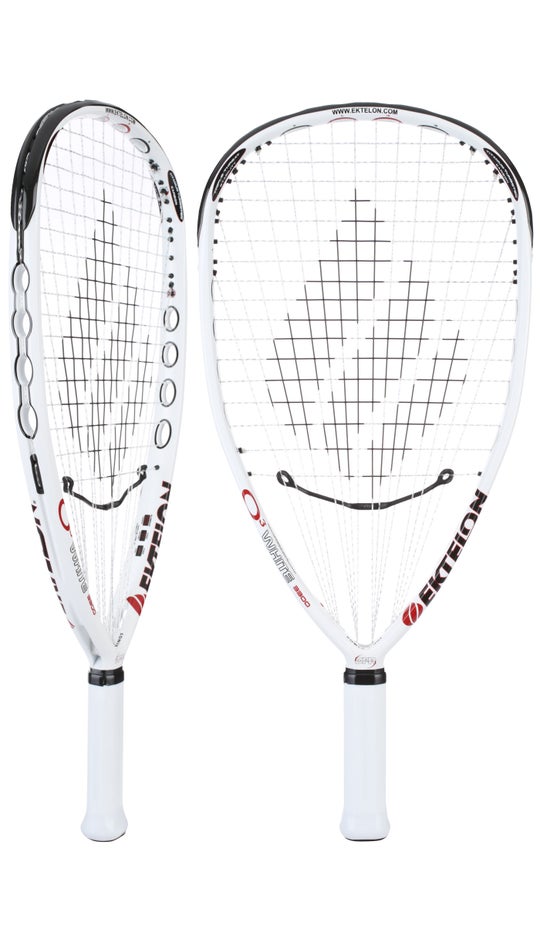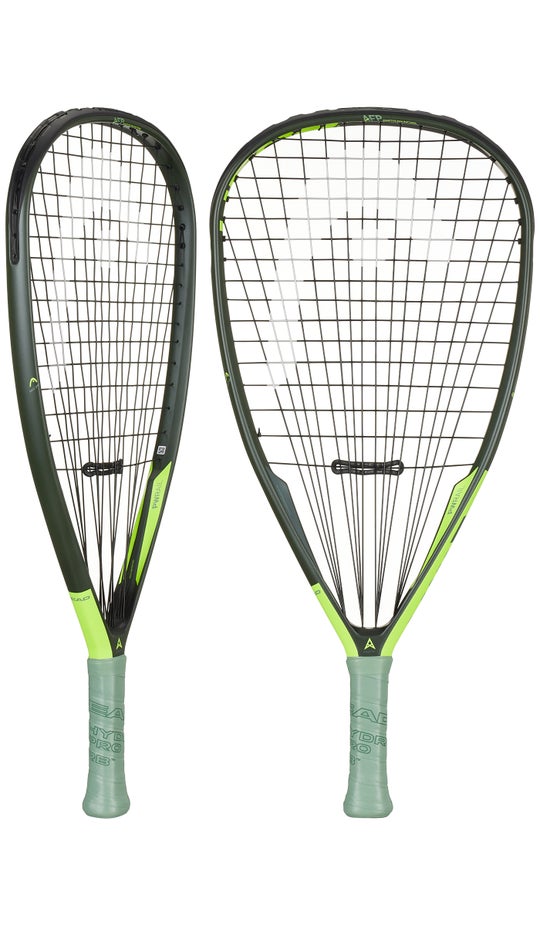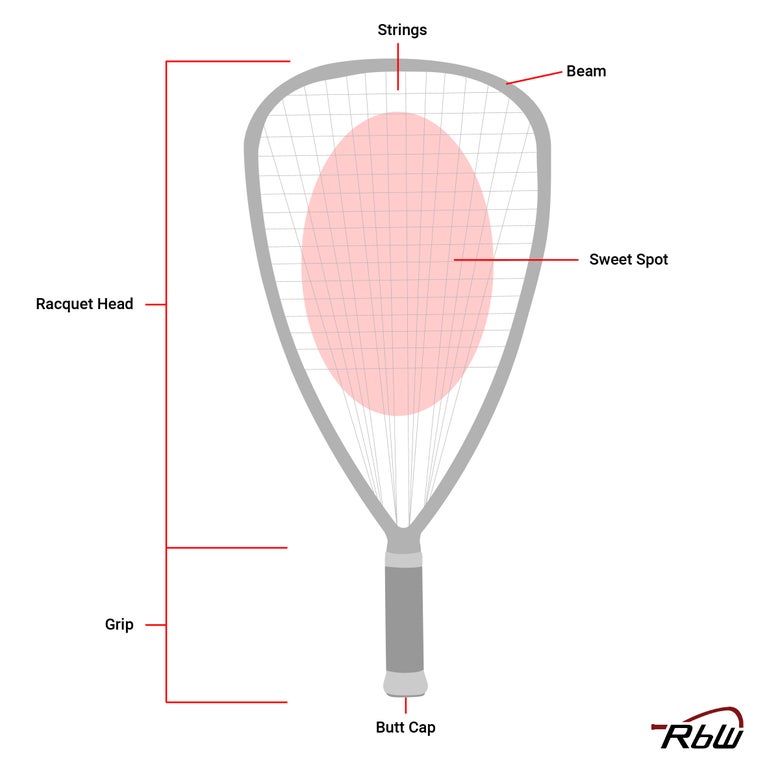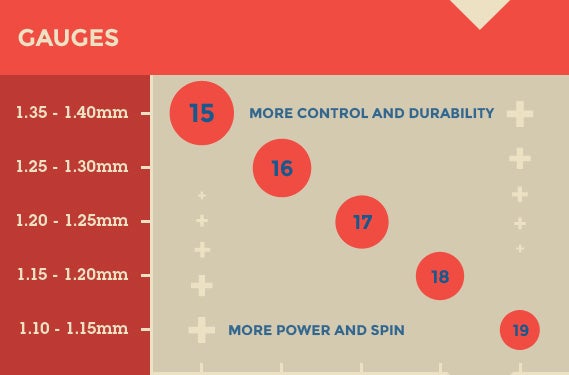Racquetball Racquet Buying Guide
If you're looking to start playing racquetball or have been playing for a while, you know that selecting the best racquet for your needs can make all the difference in your game. Your racquet is arguably your most important piece of equipment and with so many options available, it can be overwhelming to choose a racquet that will best suit you.
Our staff at Racquetball Warehouse have been helping customers select racquets for over 20 years and have organized this guide to help you choose the best racquetball racquet!
In this article, we'll discuss the key factors to consider when selecting a racquetball racquet, including racquet grip size, weight and swing speed, balance point, head shape, string, frame material and more. It should be noted that understanding these product qualities along with your skill level, physical needs, and playing style will be key for choosing a new racquet with confidence.
Before we dive into the factors that make racquetball racquets perform differently, it's important to first understand the basic anatomy of a racquet.
Racquetball Racquet Anatomy
The most basic parts of a racquetball racquet include the head, handle (grip), strings, grommets, bumper guard, and the racquet butt.
Racquet Head (Main part of frame)
The racquet head is the upper part of the racquet frame and is usually made of graphite, aluminum, or even carbon fiber. Graphite racquets tend to be lighter and more responsive, while aluminum racquets are typically heavier and more durable. Carbon fiber is the lightest of the three materials but also offers a strong, durable structure.
Racquet Handle (Grip)
The racquet handle, also known as the racquet grip, is the part of the racquet that you hold onto while playing and is arguably the most important part of a racquetball racquet. If you can’t properly grip your racquet, all other racquet qualities won’t matter. It's important to choose a grip size for your handle that feels comfortable in your hand and allows you to maintain a secure grip on the racquet.
Strings
Strings are intertwined to fill the racquet head to create a string bed and create the tension needed in order to strike the ball with the racquet. Racquetball strings are usually made of nylon or a nylon blend, with some higher-end racquets using materials like Kevlar or Vectran. Besides material, string tension and string gauge (thickness) are also important to understand for racquet performance.
Grommets & Grommet Strip
Grommets are located on each racquet string hole and their purpose is to protect each string from rubbing against the racket frame. They are the little pieces of plastic that protect each string and stick out of the racquet head. Grommets attach to the grommet strip, which typically lines the top half of your racket head. Together, grommets and the gromet strip protect your strings from wear and tear.
Bumper Guard
The bumper guard typically lines the top half of the racquet to protect the grommet strip. By providing extra protection for the grommet strip, this prevents the strings on the outside of the frame from being damaged if your racket hits or scrapes the ground. This makes the bumper guard especially useful when attempting to return low ground shots.
Racquet Butt & Butt Cap
The racquet butt is located at the base of the racquet and the butt cap is a piece of plastic that attaches to the bottom of the butt to help further protect the frame from damage when the racquet falls to the ground. The racquet butt and butt cap are not important factors for purchasing a racquet when compared to the other racquet qualities that we’ll cover next.
Factors to Consider When Choosing a Racquetball Racquet
Now that we've covered the basic anatomy of racquetball racquets, let's dive into the key factors to consider when choosing a racquet that will best fit your physical needs, skill level, and playing style.
Grip Size
As mentioned above, if you can’t properly grip your racquet, you won't be able to play the game comfortably or properly. Be sure to focus on your hand size and grip size preferences first!
Typically, racquetball grips are smaller than the standard sizes used in tennis or pickleball. The reason for this is that racquetball shots require rapid wrist action, which is facilitated by smaller grip size. However, a grip that is too small can cause the player's hand to slip, which can affect their accuracy and power. On the other hand, a grip that is too large can result in the player being unable to generate enough wrist action and power.
There are 2 basic grip size categories: Bigger or smaller. About 80% of our customers choose smaller options depending on hand size and personal preference.
Small Racquetball Racquet Grip - 3 5/8"
- The smaller grip size allows for maximum wrist snap, which translates to increased power potential based on skill level.
Larger Racquet Grips - 3 7/8" — 3 15/16"
- The larger grip size accommodates players with larger hands. For some, too small of a grip can cause wrist and elbow pain, often due to over clenching the handle or torsional instability on off-center shots.
If you haven’t watched our How to Choose a Racquetball Racquet video yet, be sure to watch the section that explains a simple test that you can do with your hands to make sure that you got the right grip size. By selecting the right grip size, you will likely enhance your performance, reduce the risk of injury, and maximize your enjoyment of the game.
Racquetball Racquet Weights & Swing Types
The weight of the racquet is another important factor to consider. A heavier racquet can provide more power and control, while a lighter racquet can provide more speed and maneuverability.
Since most beginners struggle with power and accuracy when hitting the ball, it's recommended for beginners to start with a heavier racquet and move on to a lighter racquet should they choose. Since advanced players are typically having to return balls that are hit harder, faster, with more spin, etc., having more maneuverability with the racquet is desired to allow for quicker racquet reaction and more ease in getting the racquet to be where it needs to be to return the ball.
General Swing Speed Guide
| Skill Level | Swing Type (How Fast You Swing) | Weight Range |
| Beginner | Slow | 185+ grams |
| Intermediate | Moderate | 170-180 grams |
| Advanced | Fast | 150-165 grams |
Depending on your skill level and playing style, you may want to switch between a lightweight and heavy weight racquet. Here’s an overview of the general racquetball racquet weights and swing types:
Slow Swing - Heavy Weight Racquet (185+ grams)
- Recommended for players relatively new to racquetball. Older veterans of the game often transition from a power-heavy game style to a more controlled game style and will also fit into this category. Heavyweight racquets offer the least maneuverability but generate the most power, which is often the most needed quality for beginners, older players, and or those with arm or shoulder ailments.
Moderate Swing - Medium Weight Racquet (170 - 185 grams)
- Most players fall into this category. From the avid tournament player to the weekend warrior, this category includes those players that need a little extra response and maneuverability to allow for more technical moves on the court. These racquets balance both control and power characteristics, making them a great choice for players who are exiting the beginner stage and working to develop a more advanced skill set.
Fast Swing - Light Weight Racquet (150 - 165 grams)
- Lightweight racquets offer the least power but maximize maneuverability, making them ideal for advanced and professional players that are able to generate powerful swings. Because of this, these are not recommended for players suffering from arm or shoulder ailments, such as tennis elbow for example. Increased maneuverability means increased ease with making racquet placement adjustments for returning balls.
What’s most important is to choose a weight that feels comfortable in your hand, doesn’t cause arm pain during your swing, and allows you to maintain control over the racquet during your swing.
Balance Point
The balance point of the racquet refers to the distribution of weight throughout the racquet. There are three types of racquetball racquet balance points: Head heavy, head light, and even balance racquets.
How Balance Point Fits Your Playing Style
| Balance | Effect on Performance | Player Style |
| Head Heavy | More Power | Power Player or Back Court Friendly |
| Head Light | More Maneuverability | Touch Players or Front Court Play |
| Even Balance | Balance of Power and Control | Great for Beginners |
Before you even hit a ball, it is good to get a feel for racquet balance and consider how the different balance points can affect your performance:
Head Heavy (Power player & back court friendly)
- Head heavy racquets have more weight focused at the top (head) of the racquet increasing swing weight and swing speed, which in turn increases power. These racquets are less maneuverable but generate more power and are ideal for back court players.
Head Light (Maneuverability, control & front court friendly)
- Head light racquets have more weight towards the handle (throat) making them feel lighter overall. These racquets are more maneuverable, provide a bit more control for touch players, and are ideal for frontcourt play.
Even Balance (Power & control balanced, beginner friendly)
- Even balanced point racquets have a balance point that is right in the middle of the racquet (11"). This style of racquet will provide a balance of power and control. These racquets are ideal for versatile players who find themselves all over the court and are also beginner friendly.
Be sure to choose a balance point that feels comfortable in your hand and suits your skill level or desired play style. As you advance your skill set or change your playing style, you may find that you want to experiment with racquets that have different balance points.
Racquet Head Shape
There are two main racquetball racquet head shapes to choose from: Quadraform (Sometimes referred to as squared shaped) and teardrop (Sometimes referred to as triangle shape).
Quadrafrom
Quadraform racquets have a unique shape as they are wider in the center and bottom of the head. This larger string bed design allows for a larger "sweet spot," the area on the racquet where hitting the ball produces the best results. The sweet spot on a quadraform raquet is typically located lower on the head than on a teardrop racquet. If you find that you frequently hit mishits resulting in dead balls, quadraform racquets could be a good choice.


Above, left: The Ektelon O3 White 170 has a quadraform head shape. Above, right: The Head Radical 180 has a teardrop head shape.
Teardrop
Teardrop racquets have a distinctive shape with a sharper, narrower angle from the top of the head to the bottom. The smaller string bed on a teardrop shape means a smaller sweet spot that is located higher on the racquet, making it slightly more challenging to hit the ball perfectly. However, if you are able to hit the sweet spot, you’ll generate a lot more power when compared to a quadraform racquet.
There is no head shape that is better or worse, it really comes down to personal preference. It should be noted though that most beginners typically start with a quadraform racquet due to the ease of having a larger sweet spot whereas more advanced players typically select a teardrop racquet due to the narrower but more powerful sweet spot. That being said, we recommend trying out both shapes as personal preference should outweigh skill level with selecting a racquet head shape.
Racquetball String Material, Tension, & Guage
Racquetball strings are used to create the string bed on a racquetball racquet. When selecting racquetball strings, it's crucial to consider factors such as material, tension and gauge (thickness). These factors will need to be considered alongside your skill level, playing style, and personal preferences for racquet feel.
Racquet strings are made with a variety of materials that can affect a player's performance by altering the amount of power, control, and spin they can generate with their shots.
Factory racquetball strings are the strings that come pre-installed on a new racquet when it is purchased. These strings are typically made of a standard synthetic material and are often strung at a mid-range tension. However, many players prefer to customize their racquet's string setup by choosing their preferred material.
String tension is also a critical factor in determining a racquetball racquet’s performance. Many players do not realize that while their strings haven't broken, much of the tension has been lost over time, reducing power, feel, and response.
A higher string tension can provide more control, allowing for greater accuracy and precision in shots. Conversely, a lower string tension creates a trampoline effect, which can generate better ball response, making it easier to hit more powerful shots. However, a lower tension can also result in less control over the ball's trajectory.
Racquetball string gauge refers to the thickness of the strings used. Players who prioritize power over control may prefer a thinner gauge string, while those seeking more control may choose a thicker gauge.
It's often helpful to experiment with different string setups to find the ideal combination for one's playing style. The more you practice, the more likely you are to find the right balance of tension and material to match your style and level of play. It's important to restring racquets periodically, as strings can lose tension and become worn over time, which can negatively impact a player's performance.
Frame Material
As mentioned earlier, racquetball racquet frames can be made of graphite, aluminum, or a combination of the two. Graphite racquets tend to be lighter and more responsive, making them a good choice for players who prioritize speed and agility. Aluminum racquets, on the other hand, are typically heavier and more durable, making them a good choice for players who prioritize power and durability.
There is no right or wrong answer when it comes to racquet material as this comes down to personal preference. Pricing can also be a factor as it should be noted that racquets with carbon fiber frames typically cost more than their graphite or aluminum counterparts.
Brand and Price
Lastly, it's important to consider the brand and price of the racquet. While some brands may have a reputation for producing high-quality racquets, it's important to choose a racquet model that fits your individual needs and preferences. Additionally, more expensive racquets may not necessarily be better, so it's important to consider your budget selecting a racquet.
Final Thoughts
Choosing the best racquetball racquet based on your skill level, physical needs, and playing style is essential for achieving success on the court. By considering factors such as racquet grip size, weight and swing speed, balance point, head shape, string material, tension, and guage, frame material, brand, and price, you can find a racquet that fits your individual needs and preferences.
At Racquetball Warehouse, we have tested thousands of racquetball racquets over the years and carry quality brands such as, HEAD, Ektelon, ProKennex, Gearbox, E-Force, and Wilson. We encourage you to explore our wide selection of racquetball racquets and see which one could be best for you!
FAQ's
What’s a good racquetball racquet?
A good racquetball racquet for one player may be a bad racquet to another player. It all depends on personal preference with the feel of a racquet and how that racquet affects your performance on the court. That being said, racquet feel and racquet quality are likely the two most essential considerations for determining whether a racquet is, “good”. Here’s some questions to ask yourself about racquet feel and quality:
- Racquet feel – Does the racquet feel good to grip in your hand, is it easy to swing, and does it deliver the types of shots that you desire?
- Raquet quality – Is the racquet durable, from a trustworthy brand, and do you see yourself being able to use the racquet long term?
Do more expensive racquets perform better than less expensive ones?
More expensive racquets may not necessarily perform better than less expensive ones. It's important to choose a racquet that fits your individual needs and preferences, regardless of its price. Choose a price range that works for you and stick with it. Models from previous years are a great option to save some green and still get a high-end racquet!
Can I use a racquetball racquet for other sports, such as tennis?
Racquetball racquets are specifically designed for racquetball and will not likely perform well in other racquet sports. It's important to use the appropriate equipment for each sport.


